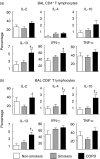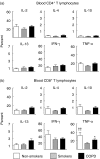Intracellular cytokine profile of T lymphocytes in patients with chronic obstructive pulmonary disease
- PMID: 16907916
- PMCID: PMC1809717
- DOI: 10.1111/j.1365-2249.2006.03167.x
Intracellular cytokine profile of T lymphocytes in patients with chronic obstructive pulmonary disease
Abstract
Chronic obstructive pulmonary disease (COPD) is characterized by an excessive inflammatory response to inhaled particles, mainly tobacco smoking. T lymphocytes are important regulatory cells that secrete several cytokines and participate actively in this inflammatory response. According to the pattern of cytokines secreted, the immune response is classified as cytotoxic or type 1 [interferon (IFN)-gamma-, interleukin (IL)-2-dependent] and humoral or type 2 (IL-4-, IL-5-, IL-10- and IL-13-dependent). This paper sought to compare the intracellular profile of cytokine expression determined by flow cytometry in T lymphocytes harvested from bronchoalveolar lavage (BAL) and peripheral blood in patients with COPD, smokers with normal lung function and never smokers. We found that BAL T lymphocytes from COPD patients had a higher percentage of positive stained cells for most of the cytokines analysed when compared to never smokers or smokers with normal lung function. Differences reached statistical significance for IL-4, IL-10 and IL-13, particularly in CD8(+) T cells. Furthermore, the expression of most of these cytokines was related inversely to the degree of airflow obstruction present suggesting local activation and/or selective homing of T lymphocytes to the lungs in COPD patients. These observations were not reproduced in circulating T lymphocytes. These results suggest that BAL T lymphocytes in patients with COPD produce more cytokines than in controls and tend to show a type 2 pattern of intracellular cytokine expression, particularly a Tc-2 profile. This is related inversely to the degree of airflow obstruction present.
Figures




References
-
- Hogg JC. Pathophysiology of airflow limitation in chronic obstructive pulmonary disease. Lancet. 2004;364:709–21. - PubMed
-
- Hogg JC, Chu F, Utokaparch S, et al. The nature of small-airway obstruction in chronic obstructive pulmonary disease. N Engl J Med. 2004;350:2645–53. - PubMed
-
- Neurath MF, Finotto S, Glimcher LH. The role of Th1/Th2 polarization in mucosal immunity. Nat Med. 2002;8:567–73. - PubMed
-
- Mattoli S, Kleimberg J, Stacey MA, Bellini A, Sun G, Marini M. The role of CD8+ Th2 lymphocytes in the development of smoking-related lung damage. Biochem Biophys Res Comms. 1997;239:146–9. - PubMed
Publication types
MeSH terms
Substances
LinkOut - more resources
Full Text Sources
Other Literature Sources
Research Materials

